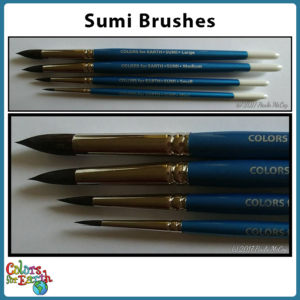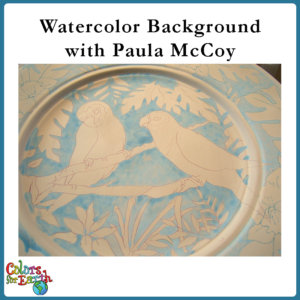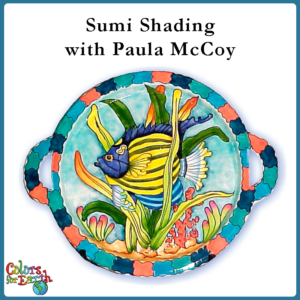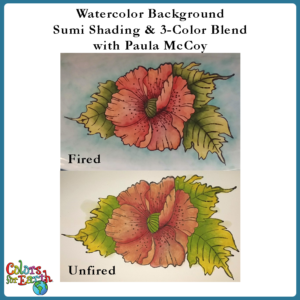Sumi Brushes
Did you know that you can use your Sumi brushes on ceramics and glass?
26 years ago I designed my “Paula McCoy/Colors for Earth” Sumi brushes. After using others on the market that were too long and hard to control for most of my students. I worked with a brush manufacturer until we got a design that would work for my students. They were originally designed to achieve a watercolor/china-painted background look in my ceramic art. Over the last few years, I have been using them in my fused glass art. I have sold thousands of these over the years and taught many students how easy they are to use.
These brushes are natural hair and taper to a point. Clean with water and lay flat to dry.
- Basecoat your ceramic designs on greenware or bisque.
- Use to shade areas on ceramics.
- Create a halo of color around your ceramic designs.
- Create multi-colored watercolor backgrounds.
- Use to apply background and shading on fused glass over Layering Mix pours and more.
- They can be used to create stripes when flattened out.
- 2 & 3-Color blending on Ceramics.
- They can be used to apply Raku glazes.
- You can create a fine line with the tip by holding them straight up and only letting the tip touch the surface.
- Because they hold so much water you can achieve a gradual blend from one color to another.
- Sumi Shading can be replaced or used in place of traditional shading done with a square shader.
Sumi Shading=Water load the brush, and drag off the edge of your water bowl to achieve a point. Tip into shadow color just on the very tip of the brush. Tuck the color by pointing the tip of the brush up next to the area where you want shading. Set the tip of the brush down and apply pressure which will flatten the bristles out. This allows the color to blend/bleed back into the water creating the darker shading where you want it, while still allowing the base coat to show through. By applying pressure while setting the brush down and moving the brush from right to left (back and forth) you will be able to blend the color to achieve a gradual color change and a watercolor effect. Once dry, the technique can be repeated to achieve a darker value. If used around a piped design this effect will create a halo of the color, which will give you the illusion that the background is a color not just white.
In my seminars and technique sheets, I describe this as “set it down, set it down, walk it to the right, walk it to the left. In my seminars, I encourage the students to say this phrase to themselves as they are doing the technique and it will help them do the shading correctly.
I hope you enjoy this technique and I look forward to seeing your creations!
Paula McCoy
Here is a link to the Sumi Brushes https://colorsforearth.com/product/sumi-set-4-brushes/
Here are some examples of pieces that were done with Sumi brushes!




















Here is a video on Sumi Shading on ceramics.



